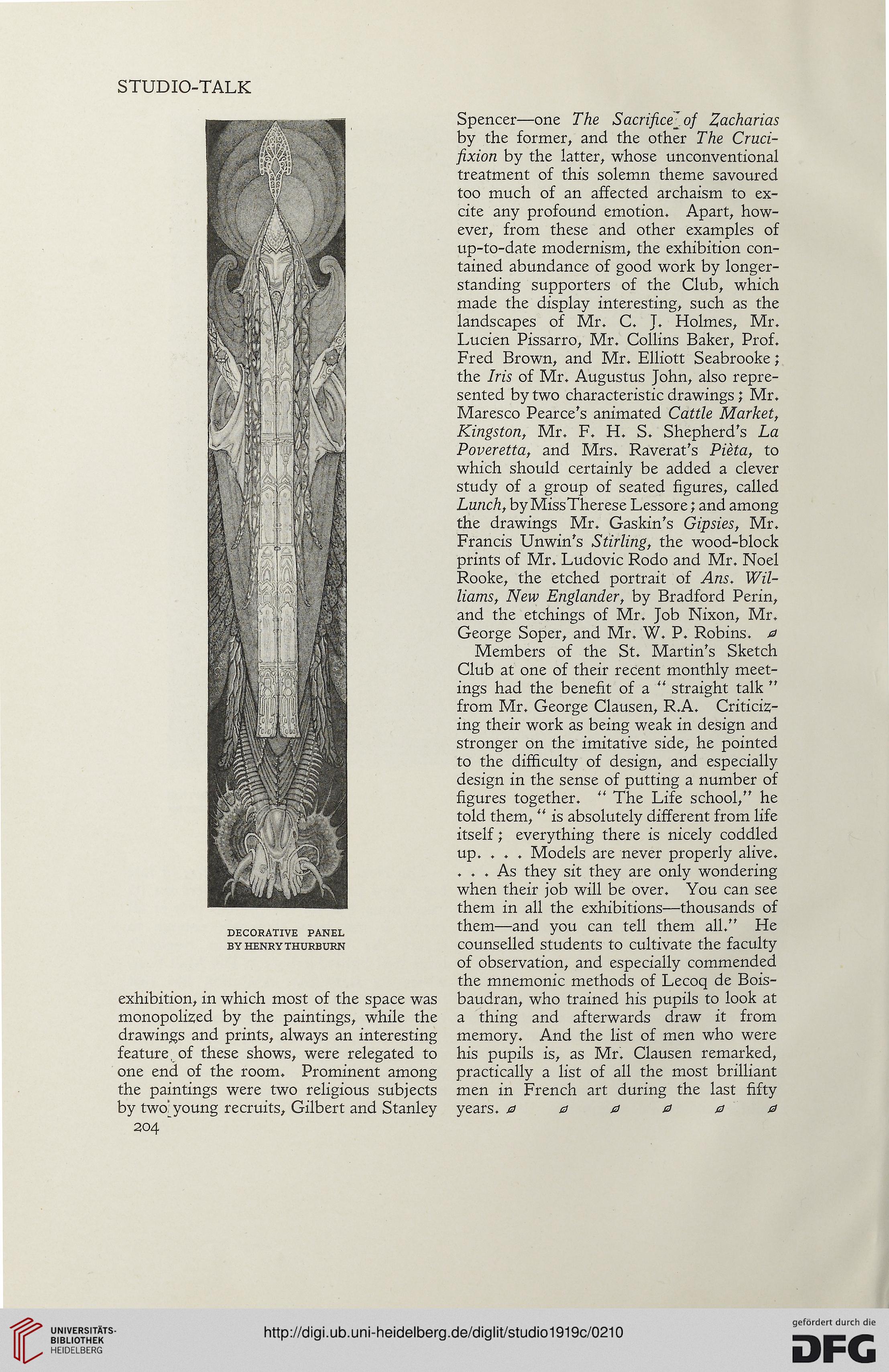STUDIO-TALK
DECORATIVE PANEL
BY HENRY THURBURN
exhibition, in which most of the space was
monopolized by the paintings, while the
drawings and prints, always an interesting
feature, of these shows, were relegated to
one end of the room. Prominent among
the paintings were two religious subjects
by two^young recruits, Gilbert and Stanley
204
Spencer—one The Sacrifice[of Zacharias
by the former, and the other The Cruci-
fixion by the latter, whose unconventional
treatment of this solemn theme savoured
too much of an affected archaism to ex-
cite any profound emotion. Apart, how-
ever, from these and other examples of
up-to-date modernism, the exhibition con-
tained abundance of good work by longer-
standing supporters of the Club, which
made the display interesting, such as the
landscapes of Mr. C. J. Holmes, Mr.
Lucien Pissarro, Mr. Collins Baker, Prof.
Fred Brown, and Mr. Elliott Seabrooke;
the Iris of Mr. Augustus John, also repre-
sented by two characteristic drawings; Mr.
Maresco Pearce's animated Cattle Market,
Kingston, Mr. F. H. S. Shepherd's La
Poveretta, and Mrs. Raverat's Pieta, to
which should certainly be added a clever
study of a group of seated figures, called
Lunch, by MissTherese Lessore; and among
the drawings Mr. Gaskin's Gipsies, Mr.
Francis Unwin's Stirling, the wood-block
prints of Mr. Ludovic Rodo and Mr. Noel
Rooke, the etched portrait of Ans. Wil-
liams, New Englander, by Bradford Perin,
and the etchings of Mr. Job Nixon, Mr.
George Soper, and Mr. W. P. Robins. 0
Members of the St. Martin's Sketch
Club at one of their recent monthly meet-
ings had the benefit of a u straight talk "
from Mr. George Clausen, R.A. Criticiz-
ing their work as being weak in design and
stronger on the imitative side, he pointed
to the difficulty of design, and especially
design in the sense of putting a number of
figures together. “ The Life school," he
told them, “ is absolutely different from life
itself; everything there is nicely coddled
up. . . . Models are never properly alive.
... As they sit they are only wondering
when their job will be over. You can see
them in all the exhibitions—thousands of
them—and you can tell them all." He
counselled students to cultivate the faculty
of observation, and especially commended
the mnemonic methods of Lecoq de Bois-
baudran, who trained his pupils to look at
a thing and afterwards draw it from
memory. And the list of men who were
his pupils is, as Mr. Clausen remarked,
practically a list of all the most brilliant
men in French art during the last fifty
years. 0 0 0 0 a 0
DECORATIVE PANEL
BY HENRY THURBURN
exhibition, in which most of the space was
monopolized by the paintings, while the
drawings and prints, always an interesting
feature, of these shows, were relegated to
one end of the room. Prominent among
the paintings were two religious subjects
by two^young recruits, Gilbert and Stanley
204
Spencer—one The Sacrifice[of Zacharias
by the former, and the other The Cruci-
fixion by the latter, whose unconventional
treatment of this solemn theme savoured
too much of an affected archaism to ex-
cite any profound emotion. Apart, how-
ever, from these and other examples of
up-to-date modernism, the exhibition con-
tained abundance of good work by longer-
standing supporters of the Club, which
made the display interesting, such as the
landscapes of Mr. C. J. Holmes, Mr.
Lucien Pissarro, Mr. Collins Baker, Prof.
Fred Brown, and Mr. Elliott Seabrooke;
the Iris of Mr. Augustus John, also repre-
sented by two characteristic drawings; Mr.
Maresco Pearce's animated Cattle Market,
Kingston, Mr. F. H. S. Shepherd's La
Poveretta, and Mrs. Raverat's Pieta, to
which should certainly be added a clever
study of a group of seated figures, called
Lunch, by MissTherese Lessore; and among
the drawings Mr. Gaskin's Gipsies, Mr.
Francis Unwin's Stirling, the wood-block
prints of Mr. Ludovic Rodo and Mr. Noel
Rooke, the etched portrait of Ans. Wil-
liams, New Englander, by Bradford Perin,
and the etchings of Mr. Job Nixon, Mr.
George Soper, and Mr. W. P. Robins. 0
Members of the St. Martin's Sketch
Club at one of their recent monthly meet-
ings had the benefit of a u straight talk "
from Mr. George Clausen, R.A. Criticiz-
ing their work as being weak in design and
stronger on the imitative side, he pointed
to the difficulty of design, and especially
design in the sense of putting a number of
figures together. “ The Life school," he
told them, “ is absolutely different from life
itself; everything there is nicely coddled
up. . . . Models are never properly alive.
... As they sit they are only wondering
when their job will be over. You can see
them in all the exhibitions—thousands of
them—and you can tell them all." He
counselled students to cultivate the faculty
of observation, and especially commended
the mnemonic methods of Lecoq de Bois-
baudran, who trained his pupils to look at
a thing and afterwards draw it from
memory. And the list of men who were
his pupils is, as Mr. Clausen remarked,
practically a list of all the most brilliant
men in French art during the last fifty
years. 0 0 0 0 a 0




